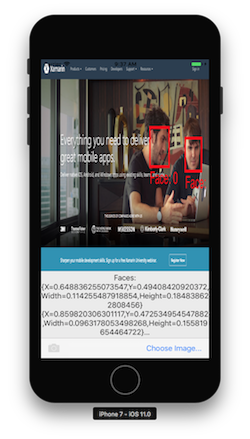Vision Framework in Xamarin.iOS
The Vision framework adds a number of new image processing features to iOS 11, including:
- Rectangle Detection
- Face Detection
- Machine Learning Image Analysis (discussed in CoreML)
- Barcode Detection
- Image Alignment Analysis
- Text Detection
- Horizon Detection
- Object Detection & Tracking


Rectangle Detection and Face Detection are discussed in more detail below.
Rectangle Detection
The sample shows how to process an image and draw the detected rectangles on it.
1. Initialize the Vision request
In ViewDidLoad, create a VNDetectRectanglesRequest that references
the HandleRectangles method which will be called at the end of each request:
The MaximumObservations property should also be set, otherwise it will default to 1 and only a single result will be returned.
RectangleRequest = new VNDetectRectanglesRequest(HandleRectangles);
RectangleRequest.MaximumObservations = 10;
2. Start the Vision processing
The following code starts processing the request. In the VisionRects sample, this code runs after the user has selected an image:
// Run the rectangle detector
var handler = new VNImageRequestHandler(ciImage, uiImage.Orientation.ToCGImagePropertyOrientation(), new VNImageOptions());
DispatchQueue.DefaultGlobalQueue.DispatchAsync(()=>{
handler.Perform(new VNRequest[] {RectangleRequest}, out NSError error);
});
This handler passes the ciImage to the Vision framework VNDetectRectanglesRequest that was created in step 1.
3. Handle the results of Vision processing
Once the rectangle detection is complete, the framework executes the HandleRectangles method,
a summary of which is shown below:
private void HandleRectangles(VNRequest request, NSError error){
var observations = request.GetResults<VNRectangleObservation>();
// ... omitted error handling ...
bool atLeastOneValid = false;
foreach (var o in observations){
if (InputImage.Extent.Contains(boundingBox)) {
atLeastOneValid |= true;
}
}
if (!atLeastOneValid) return;
// Show the pre-processed image
DispatchQueue.MainQueue.DispatchAsync(() =>
{
ClassificationLabel.Text = summary;
ImageView.Image = OverlayRectangles(RawImage, imageSize, observations);
});
}
4. Display the results
The OverlayRectangles method in the VisionRectangles sample has three functions:
- Rendering the source image,
- Drawing a rectangle to indicate where each one was detected, and
- Adding a text label for each rectangle using CoreGraphics.

5. Further processing
Rectangle detection is often just the first step in a chain of operations, such as with this CoreMLVision example, where the rectangles are passed to a CoreML model to parse handwritten digits.
Face Detection
This sample works in a similar fashion to the VisionRectangles sample, using a different Vision request class.
1. Initialize the Vision request
In ViewDidLoad, create a VNDetectFaceRectanglesRequest that references the HandleRectangles method which will be called at the end of each request.
FaceRectangleRequest = new VNDetectFaceRectanglesRequest(HandleRectangles);
2. Start the Vision processing
The following code starts processing the request. In the VisionFaces sample this code runs after the user has selected an image:
// Run the face detector
var handler = new VNImageRequestHandler(ciImage, uiImage.Orientation.ToCGImagePropertyOrientation(), new VNImageOptions());
DispatchQueue.DefaultGlobalQueue.DispatchAsync(()=>{
handler.Perform(new VNRequest[] {FaceRectangleRequest}, out NSError error);
});
This handler passes the ciImage to the Vision framework VNDetectFaceRectanglesRequest that was created in step 1.
3. Handle the results of Vision processing
Once the face detection is complete, the handler executes the HandleRectangles method
which performs error handling and displays the bounds of the detected faces, and calls the
OverlayRectangles to draw bounding rectangles on the original picture:
private void HandleRectangles(VNRequest request, NSError error){
var observations = request.GetResults<VNFaceObservation>();
// ... omitted error handling...
var summary = "";
var imageSize = InputImage.Extent.Size;
bool atLeastOneValid = false;
Console.WriteLine("Faces:");
summary += "Faces:";
foreach (var o in observations) {
// Verify detected rectangle is valid. omitted
var boundingBox = o.BoundingBox.Scaled(imageSize);
if (InputImage.Extent.Contains(boundingBox)) {
atLeastOneValid |= true;
}
}
// Show the pre-processed image (on UI thread)
DispatchQueue.MainQueue.DispatchAsync(() =>
{
ClassificationLabel.Text = summary;
ImageView.Image = OverlayRectangles(RawImage, imageSize, observations);
});
}
4. Display the results
The OverlayRectangles method in the VisionFaces sample has three functions:
- Rendering the source image,
- Drawing a rectangle for each face detected, and
- Adding a text label for each face using CoreGraphics.

5. Further processing
The Vision framework includes additional capabilities to detect
facial features, such as the eyes and mouth. Use the
VNDetectFaceLandmarksRequest type, which will return
VNFaceObservation results as in step 3 above, but with additional
VNFaceLandmark data.